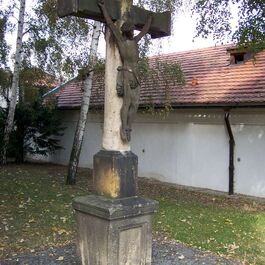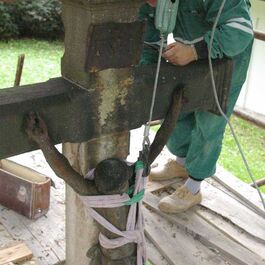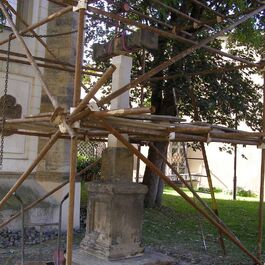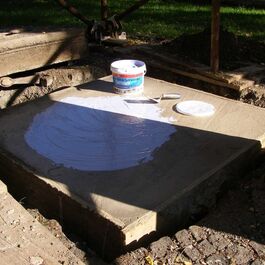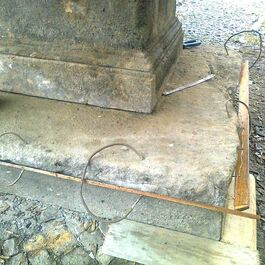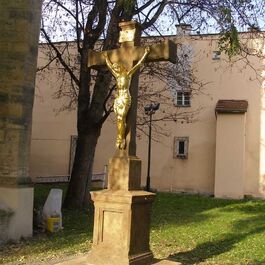Cross at the Church of St. Roch in Strahov
The immovable cultural monument "Cross with the Corpus of Christ on a Profiled Base" from the turn of the 19th and 20th centuries by an unknown author, stands 350 cm tall, of which the Corpus Christi is 125 cm. The cross is made from Žehrovický sandstone, and the corpus is cast iron, originally gilded. It stands on a square base measuring 140 x 140 cm.
- Restorers: academic sculptor Petr Váňa and stonemason Tomáš Váňa
- Implementation: 2011
- Registration number ÚSKP: 11720/1-904
- Monument name: Cross with the Corpus of Christ on a Profiled Base.
- Cadastral area: Hradčany (district Prague), 727121
Financial contributors to the restoration
- Royal Canonry of Premonstratensians at Strahov
Condition before restoration
The stone part of the cross was deteriorated in places due to rising moisture. The surface was flaked, including parts of the profiling, especially on the vertical beam. The cross also had defects caused mechanically. The entire stone surface was variously contaminated and covered with green algae.
The cast iron parts of the Corpus Christi and the inscription ribbon were affected by corrosion, which also damaged the modeling in some places. The original gilding was not preserved and was discovered only through surveying.
The square base measuring 140 x 140 x 20 was recessed below the level of the surrounding pavement and was not visually presented. This resulted in moisture rising into the lower part of the cross, leading to its subsequent degradation.
Restoration process
Initially, scaffolding was erected around the entire monument, which also served as roofing. Nuts on the wrought hinges, which were significantly corroded, were loosened. Following consultation with a heritage conservation supervisor, new hinges were made from stainless steel. The Corpus Christi and the inscription ribbon were dismantled and transported to the restorer's studio, where they were cleaned and re-gilded with 24-carat gold of doubled thickness for outdoor use.
The entire surface of the stone cross was cleaned with high-pressure water and a biocidal agent (Cpaper). Locally, the stone was further cleaned with Čistič FG cleaner. After drying, the damaged stone was consolidated with a consolidant.
During a technological break, a copy of the vertical beam of the cross was made. This was followed by the replacement of the vertical beam. During this, unsuitable brass pins were replaced. At the same time, the recessed foundation slab was raised to be leveled with the current ground surface. After the shoring dried, the entire cross was reassembled. The foundation slab, due to moisture, was set on lead sheets and lime mortar, as were the other parts of the cross.
The final step involved a total color retouch to match the basic color of the cleaned sandstone with azure sprays, preserving the natural color corresponding to its age. The final phase was the overall hydrophobization of the surface with IMESTA IW 290 and the reinstallation of the Corpus Christi with the inscription ribbon.



